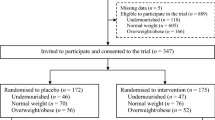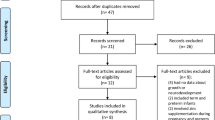Abstract
Background/objective:
To assess the effects of micronutrient supplementation on head circumference of rural Nepali infants and children.
Subjects/methods:
We used a randomized controlled trial to assess the effects of micronutrient supplementation on head circumference in 569 rural Nepali infants and children aged 4–17 months. Children were randomized to: (1) zinc, (2) iron–folic acid, (3) zinc plus iron–folic acid or (4) a placebo group. Data on head circumference were collected during five visits at ∼3 month intervals over the course of a year. We calculated change in head circumference in treatment groups receiving zinc and iron comparing the first and fifth visits as well as used generalized estimating equations (GEE) to take advantage of data from all points in time. Models were adjusted for covariates unbalanced in the randomization and for baseline head circumference.
Results:
Estimating differences in head circumference between baseline and visit 5, children in the zinc treatment group showed smaller decreases in head circumference z-score compared with placebo (adjusted β=0.13, 95% confidence interval (CI): 0.03 to 0.23). Using GEE, zinc treatment was associated with 0.11 (95% CI: 0.05 to 0.17) decrease in the rate of decline in head circumference z-score across visits as compared with placebo. Iron–folic acid supplementation was not associated with head circumference z-scores when comparing visits 1 with 5 or including data across all visits in adjusted models.
Conclusion:
Our results suggest that zinc supplementation confers a beneficial effect on the rate of head growth in Nepali infants.
This is a preview of subscription content, access via your institution
Access options
Subscribe to this journal
Receive 12 print issues and online access
$259.00 per year
only $21.58 per issue
Buy this article
- Purchase on SpringerLink
- Instant access to full article PDF
Prices may be subject to local taxes which are calculated during checkout


Similar content being viewed by others
References
Hansen D, Lou HC . Brain development, head circumference and medication. Acta Paediatr 2000; 89: 505–507.
Brandt I . Brain growth, fetal malnutrition, and clinical consequences. J Perinat Med 1981; 9: 3–26.
Dolk H . The predictive value of microcephaly during the first year of life for mental retardation at seven years. Dev Med Child Neurol 1991; 33: 974–983.
Nelson KB, Deutschberger J . Head size at one year as a predictor of four-year IQ. Dev Med Child Neurol 1970; 12: 487–495.
Fisch RO, Bilek MK, Horrobin JM, Chang PN . Children with superior intelligence at 7 years of age: A prospective study of the influence of perinatal, medical, and socioeconomic factors. Am J Dis Child 1976; 130: 481–487.
Garcia-Alix A, Saenz-de Pipaon M, Martinez M, Salas-Hernandez S, Quero J . Ability of neonatal head circumference to predict long-term neurodevelopmental outcome. Rev Neurol 2004; 39: 548–554.
Peterson J, Taylor HG, Minich N, Klein N, Hack M . Subnormal head circumference in very low birth weight children: neonatal correlates and school-age consequences. Early Hum Dev 2006; 82: 325–334.
Gale CR, O’Callaghan FJ, Godfrey KM, Law CM, Martyn CN . Critical periods of brain growth and cognitive function in children. Brain 2004; 127: 321–329.
Lundgren EM, Cnattingius S, Jonsson B, Tuvemo T . Birth characteristics and different dimensions of intellectual performance in young males: a nationwide population-based study. Acta Paediatr 2003; 92: 1138–1143.
Heinonen K, Raikkonen K, Pesonen AK, Kajantie E, Andersson S, Eriksson JG et al. Prenatal and postnatal growth and cognitive abilities at 56 months of age: A longitudinal study of infants born at term. Pediatrics 2008; 121: e1325–e1333.
Veena SR, Krishnaveni GV, Wills AK, Kurpad AV, Muthayya S, Hill JC et al. Association of birthweight and head circumference at birth to cognitive performance in 9- to 10-year-old children in south India: Prospective birth cohort study. Pediatr Res 2010; 67: 424–429.
Ivanovic DM, Leiva BP, Perez HT, Inzunza NB, Almagia AF, Toro TD et al. Long-term effects of severe undernutrition during the first year of life on brain development and learning in Chilean high-school graduates. Nutrition 2000; 16: 1056–1063.
Ivanovic DM, Leiva BP, Perez HT, Almagia AF, Toro TD, Urrutia M et al. Nutritional status, brain development and scholastic achievement of Chilean high-school graduates from high and low intellectual quotient and socio-economic status. Br J Nutr 2002; 87: 81–92.
Georgieff MK, Hoffman JS, Pereira GR, Bernbaum J, Hoffman-Williamson M . Effect of neonatal caloric deprivation on head growth and 1-year developmental status in preterm infants. J Pediatr 1985; 107: 581–587.
Brandt I, Sticker EJ, Lentze MJ . Catch-up growth of head circumference of very low birth weight, small for gestational age preterm infants and mental development to adulthood. J Pediatr 2003; 142: 463–468.
Brown JL, Pollitt E . Malnutrition, poverty and intellectual development. Sci Am 1996; 274: 38–43.
Tielsch JM, Khatry SK, Stoltzfus RJ, Katz J, LeClerq SC, Adhikari R et al. Effect of daily zinc supplementation on child mortality in southern Nepal: a community-based, cluster randomised, placebo-controlled trial. Lancet 2007; 370: 1230–1239.
Siegel EH, Stoltzfus RJ, Khatry SK, Leclerq SC, Katz J, Tielsch JM . Epidemiology of anemia among 4- to 17-month-old children living in south central Nepal. Eur J Clin Nutr 2006; 60: 228–235.
Tielsch JM, Khatry SK, Stoltzfus RJ, Katz J, LeClerq SC, Adhikari R et al. Effect of routine prophylactic supplementation with iron and folic acid on preschool child mortality in southern Nepal: community-based, cluster-randomised, placebo-controlled trial. Lancet 2006; 367: 144–152.
Siegel EH, Stoltzfus RJ, Kariger PK, Katz J, Khatry SK, LeClerq SC et al. Growth indices, anemia, and diet independently predict motor milestone acquisition of infants in south central Nepal. J Nutr 2005; 135: 2840–2844.
Siegel EH, Kordas K, Stoltzfus RJ, Katz J, Khatry SK, LeClerc SC et al. Inconsistent effects of iron-folic acid and/or zinc supplementation on the cognitive development of infants. J Health Popul Nutr 2011; 29: 593–604.
Zeger SL, Liang KY . Longitudinal data analysis for discrete and continuous outcomes. Biometrics 1986; 42: 121–130.
Victora CG, de Onis M, Hallal PC, Blossner M, Shrimpton R . Worldwide timing of growth faltering: revisiting implications for interventions. Pediatrics 2010; 125: e473–e480.
Malina RM, Habicht JP, Martorell R, Lechtig A, Yarbrough C, Klein RE . Head and chest circumferences in rural Guatemalan Ladino children, birth to seven years of age. Am J Clin Nutr 1975; 28: 1061–1070. (Comparative Study Research Support, US Government, PHS).
Cooke RW, Lucas A, Yudkin PL, Pryse-Davies J . Head circumference as an index of brain weight in the fetus and newborn. Early Hum Dev 1977; 1: 145–149.
Gale CR, O’Callaghan FJ, Bredow M, Martyn CN . The influence of head growth in fetal life, infancy, and childhood on intelligence at the ages of 4 and 8 years. Pediatrics 2006; 118: 1486–1492.
Krebs NF, Westcott JE, Butler N, Robinson C, Bell M, Hambidge KM . Meat as a first complementary food for breastfed infants: feasibility and impact on zinc intake and status. J Pediatr Gastroenterol Nutr 2006; 42: 207–214.
Rivera JA, Ruel MT, Santizo MC, Lonnerdal B, Brown KH . Zinc supplementation improves the growth of stunted rural Guatemalan infants. J Nutr 1998; 128: 556–562.
Friel JK, Andrews WL, Matthew JD, Long DR, Cornel AM, Cox M et al. Zinc supplementation in very-low-birth-weight infants. J Pediatr Gastroenterol Nutr 1993; 17: 97–104.
Marriott LD, Foote KD, Bishop JA, Kimber AC, Morgan JB . Weaning preterm infants: a randomised controlled trial. Arch Dis Child Fetal Neonatal Ed 2003; 88: F302–F307.
Haschke F, Singer P, Baumgartner D, Steffan I, Schilling R, Lothaller H . Growth, zinc and copper nutritional status of male premature infants with different zinc intake. Ann Nutr Metab 1985; 29: 95–102.
Danesh A, Janghorbani M, Mohammadi B . Effects of zinc supplementation during pregnancy on pregnancy outcome in women with history of preterm delivery: a double-blind randomized, placebo-controlled trial. J Matern Fetal Neonatal Med 2010; 23: 403–408.
Christian P, Khatry SK, Katz J, Pradhan EK, LeClerq SC, Shrestha SR et al. Effects of alternative maternal micronutrient supplements on low birth weight in rural Nepal: double blind randomised community trial. BMJ 2003; 326: 571.
Goldenberg RL, Tamura T, Neggers Y, Copper RL, Johnston KE, DuBard MB et al. The effect of zinc supplementation on pregnancy outcome. JAMA 1995; 274: 463–468.
Merialdi M, Caulfield LE, Zavaleta N, Figueroa A, Costigan KA, Dominici F et al. Randomized controlled trial of prenatal zinc supplementation and fetal bone growth. Am J Clin Nutr 2004; 79: 826–830.
Caulfield LE, Zavaleta N, Figueroa A, Leon Z . Maternal zinc supplementation does not affect size at birth or pregnancy duration in Peru. J Nutr 1999; 129: 1563–1568.
Osendarp SJ, van Raaij JM, Arifeen SE, Wahed M, Baqui AH, Fuchs GJ . A randomized, placebo-controlled trial of the effect of zinc supplementation during pregnancy on pregnancy outcome in Bangladeshi urban poor. Am J Clin Nutr 2000; 71: 114–119.
Meeks Gardner J, Witter MM, Ramdath DD . Zinc supplementation: effects on the growth and morbidity of undernourished Jamaican children. Eur J Clin Nutr 1998; 52: 34–39.
Lagiou P, Mucci L, Tamimi R, Kuper H, Lagiou A, Hsieh CC et al. Micronutrient intake during pregnancy in relation to birth size. Eur J Nutr 2005; 44: 52–59.
Sachdev H, Gera T, Nestel P . Effect of iron supplementation on physical growth in children: systematic review of randomised controlled trials. Public Health Nutr 2006; 9: 904–920.
Beckett C, Durnin JV, Aitchison TC, Pollitt E . Effects of an energy and micronutrient supplement on anthropometry in undernourished children in Indonesia. Eur J Clin Nutr 2000; 54 (Suppl 2): S52–S59.
Osrin D, Vaidya A, Shrestha Y, Baniya RB, Manandhar DS, Adhikari RK et al. Effects of antenatal multiple micronutrient supplementation on birthweight and gestational duration in Nepal: double-blind, randomised controlled trial. Lancet 2005; 365: 955–962.
Sachdeva R, Mann SK . Impact of nutrition education and medical supervision on pregnancy outcome. Indian Pediatr 1993; 30: 1309–1314.
Brandão-Neto J, Stefan V, Mendonça BB, Bloise W, Castro AVB . The essential role of zinc in growth. Nutr Research 1995; 15: 335–358.
Ruz M . Zinc supplementation and growth. Curr Opin Clin Nutr Metab Care 2006; 9: 757–762.
Acknowledgements
The authors would like to thank Shivani Patel for her contribution to the statistical analyses. Support for this study was received from grants by the National Institutes of Health, Bethesda, MD, USA (HD 38753), the Bill and Melinda Gates Foundation, Seattle, WA, USA (810-2054) and a Cooperative Agreement between Johns Hopkins University and the Office of Health and Nutrition, US Agency for International Development, Washington, DC, USA (HRN-A-00-97-00015-00).
Funding: The study sponsors did not have a role in study design, data collection, analysis, interpretation or the writing of this report.
Author information
Authors and Affiliations
Corresponding author
Ethics declarations
Competing interests
The authors declare no conflict of interest.
Rights and permissions
About this article
Cite this article
Surkan, P., Shankar, M., Katz, J. et al. Beneficial effects of zinc supplementation on head circumference of Nepalese infants and toddlers: a randomized controlled trial. Eur J Clin Nutr 66, 836–842 (2012). https://doi.org/10.1038/ejcn.2012.42
Received:
Revised:
Accepted:
Published:
Issue date:
DOI: https://doi.org/10.1038/ejcn.2012.42



